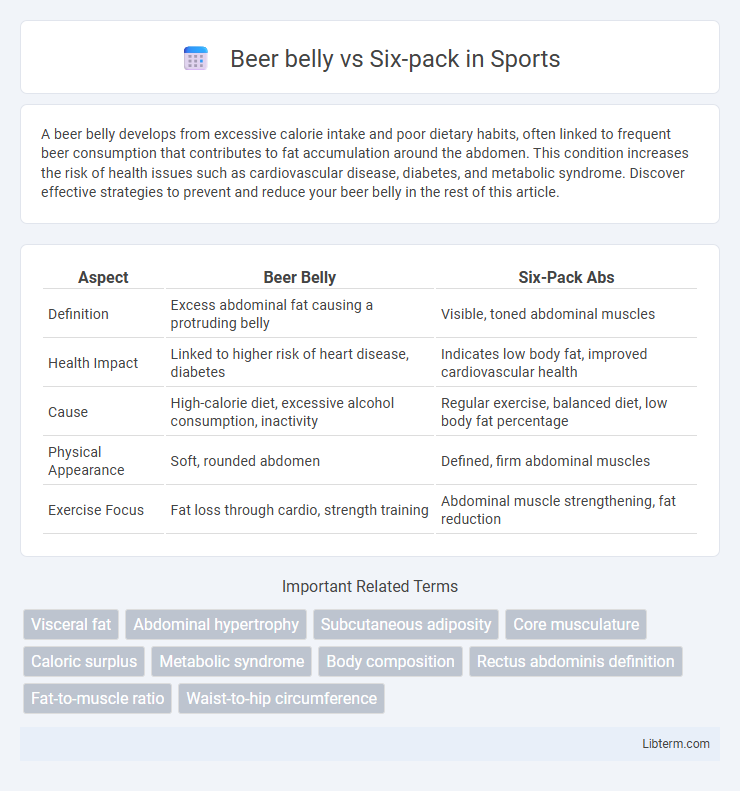A beer belly develops from excessive calorie intake and poor dietary habits, often linked to frequent beer consumption that contributes to fat accumulation around the abdomen. This condition increases the risk of health issues such as cardiovascular disease, diabetes, and metabolic syndrome. Discover effective strategies to prevent and reduce your beer belly in the rest of this article.
Table of Comparison
| Aspect | Beer Belly | Six-Pack Abs |
|---|---|---|
| Definition | Excess abdominal fat causing a protruding belly | Visible, toned abdominal muscles |
| Health Impact | Linked to higher risk of heart disease, diabetes | Indicates low body fat, improved cardiovascular health |
| Cause | High-calorie diet, excessive alcohol consumption, inactivity | Regular exercise, balanced diet, low body fat percentage |
| Physical Appearance | Soft, rounded abdomen | Defined, firm abdominal muscles |
| Exercise Focus | Fat loss through cardio, strength training | Abdominal muscle strengthening, fat reduction |
Understanding the Beer Belly Phenomenon
A beer belly results from excessive visceral fat accumulation around the abdomen, often caused by high-calorie intake and sedentary lifestyle, contrasting sharply with the low body fat and well-defined muscles characteristic of a six-pack. This phenomenon is linked to metabolic factors such as insulin resistance and increased cortisol levels, which promote fat storage in the midsection. Understanding these biological mechanisms helps emphasize the importance of balanced nutrition and regular exercise for preventing visceral fat buildup and achieving a toned abdominal appearance.
What Defines a Six-Pack Abs?
A six-pack abs is defined by the visibility of the rectus abdominis muscles, characterized by well-developed and separated muscle segments. Low body fat percentage, typically below 10-12%, is essential to reveal the muscle definition and achieve the desired six-pack appearance. In contrast, a beer belly results from excess visceral fat accumulation around the abdomen, obscuring muscle definition despite abdominal strength.
Causes of Beer Belly: Diet, Genes, and Lifestyle
Excess beer belly often results from a combination of poor diet, genetic predisposition, and sedentary lifestyle, where high-calorie intake from alcohol and processed foods promotes visceral fat accumulation. Genetic factors influence fat distribution and metabolism, making some individuals more prone to abdominal obesity despite similar lifestyles. Sedentary habits reduce calorie expenditure, exacerbating fat storage around the midsection, contrasting with the low body fat and muscle definition seen in six-pack abs.
Anatomy of Abdominal Muscles
The anatomy of abdominal muscles includes the rectus abdominis, external obliques, internal obliques, and transverse abdominis, which together form the core structure that determines the appearance of the stomach. A six-pack is visible when the rectus abdominis muscles are well-defined and the subcutaneous fat layer is minimal, revealing the segmented muscle patterns. In contrast, a beer belly results from excessive visceral fat accumulation around the abdominal organs, obscuring muscle definition and causing the abdomen to protrude.
Health Risks of a Beer Belly
A beer belly, characterized by excess visceral fat around the abdomen, significantly increases the risk of heart disease, type 2 diabetes, and metabolic syndrome compared to having a six-pack with low body fat. Visceral fat releases inflammatory markers and hormones that impair insulin sensitivity and promote atherosclerosis, contributing to chronic health conditions. In contrast, a six-pack signifies strong abdominal muscles and minimal visceral fat, indicating better overall metabolic health and reduced risk of cardiovascular issues.
Six-Pack Abs: Myths vs. Reality
Six-pack abs represent visible, well-defined abdominal muscles often associated with physical fitness and low body fat percentage. Contrary to common myths, achieving six-pack abs requires a combination of consistent exercise, proper nutrition, and overall body fat reduction rather than just performing countless abdominal crunches. Genetics also play a crucial role in the shape and visibility of six-pack abs, meaning not everyone will achieve the same definition despite similar efforts.
Nutrition Tips: Beer Belly vs Six-Pack
Reducing a beer belly requires cutting down on excess calories, especially from sugary drinks and alcohol, while increasing protein intake to promote fat loss. For achieving a six-pack, prioritize lean proteins, complex carbohydrates, and healthy fats to support muscle growth and reduce body fat. Consistent hydration, balanced meals rich in fiber, and avoiding processed foods enhance metabolic health and abdominal definition.
Exercise Regimens: Shedding Fat or Sculpting Abs
Targeted exercise regimens for a beer belly focus on high-intensity interval training (HIIT) and full-body cardio workouts that accelerate fat loss and increase metabolism. Sculpting a six-pack requires core-centric strength training exercises such as planks, leg raises, and crunches combined with a controlled, calorie-deficit diet to reveal abdominal muscles. Consistency in combining fat-burning activities with muscle-toning workouts optimizes results and transforms the midsection effectively.
Psychological Impact: Confidence and Body Image
A beer belly often leads to decreased confidence and negative body image due to societal stigma associating it with poor health and lifestyle choices. In contrast, a six-pack is widely perceived as a symbol of physical fitness and discipline, boosting self-esteem and positive body image. Psychological research highlights that individuals with a six-pack experience greater social acceptance and internal satisfaction compared to those with a beer belly.
Achieving Your Fitness Goal: Beer Belly to Six-Pack
Transforming a beer belly into a six-pack requires a combination of consistent cardiovascular exercise, strength training, and a disciplined nutrition plan centered on calorie deficit and high protein intake. Reducing visceral fat, which accumulates around the abdomen, improves metabolic health and reveals underlying abdominal muscles developed through targeted core workouts. Tracking progress with body composition measurements ensures effective fat loss and muscle gain, accelerating the achievement of a defined six-pack.
Beer belly Infographic

 libterm.com
libterm.com